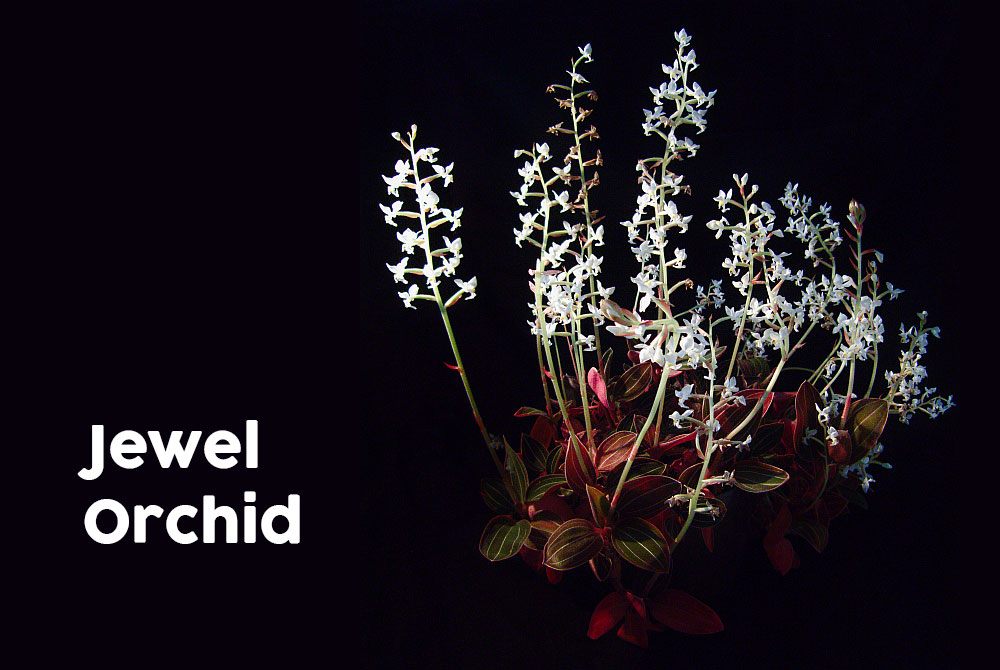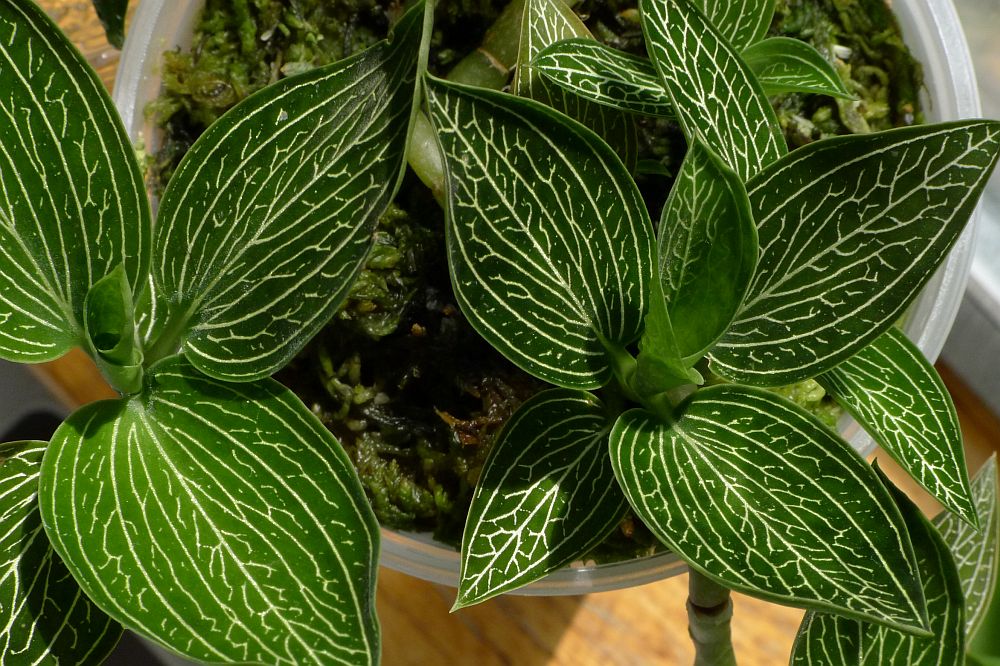Jewel Orchid (Ludisia Discolor) – How to Grow and Care for Jewel Orchids
Say what you like about orchids, I think we can all agree that they bring a spirit of whimsical joy to every house. Jewel orchids or Ludisia discolor, are no different. While other orchards are literal showboats with their stunning flowers and delicate fragrance, velvety greenish-maroon foliage is our Ludisia’s pride and joy.

If you want to add a touch of lively tropical colors to your decor, then the jewel orchid is the right houseplant for you. It’s not fussy about water and nutrients, and it won’t demand constant care and attention on your part. So what do you need to know about the jewel orchid before you invite it into your home? And how would you grow and care for it? Read on to find an answer to all these questions.
About the Jewel Orchid
As a native of Southeast Asia, the jewel orchid is often found on tropical forest floors as well as a permanent fixture in many homes. The leaves are its most striking feature even though it still produces small blooms that enhance the visual appeal of the plant as a whole.
Jewel orchids live for many years and with proper care will grow and propagate quickly. This might come as a surprise to you since the common misconception about jewel orchids is that they’re hard to grow and are not easily found in nurseries. Perhaps the only prerequisite that this Ludisia needs is a hot and humid environment that mimics its native origins.
As annual flowering plants, the flowering season is something to look for. The flowers appear as buds on long spikes that shoot up out of the plant quickly. Then the buds open to reveal small white flowers that dot the deep maroon leaves like jewels or tiny stars. The flowers, though lack fragrance, will stay in full bloom for about a month.
Jewel Orchid Varieties
While admittedly rare in nurseries outside of their flowering season, and while the whole Ludisia genus only contains one member, the Ludisia discolor, two types of jewel orchids are often sold in the market.
- Black Jewel Orchid: the most distinguishing feature of this Ludisia orchid is its dark green leaves. They are almost black until you shine a strong light on them to reveal pale veins and pinstripes crisscrossing the deep green landscape. The maroon coloring gives the leaves and veins rich and vibrant undertones. When the white flowers bloom, that’s when the plant shows its full beauty and majesty. This by far is the more popular of the two jewel orchid varieties and the one you’re most likely to find on sale.
- Ludisia Discolor Alba: the Alba is similar to the Black Jewel Orchid in many ways except for the colors. The leaves are bright green and the veins are whitish and more pronounced. It lacks the maroon undertones so the white flowers are not as prominent as with the other Ludisia variety. It still has ornamental value although it’s harder to come by than its darker cousin.

Another plant with a similar name is the Lightning Bolt Jewel Orchid. However, it’s a totally different species as its scientific name, Macodes petola, shows. It has large leaves but the veins are less regular and more intricate with brighter hues like lightning bolts. This plant isn’t as fast-growing as the Ludisia and is also much smaller.
How to Grow Jewel Orchids
Perhaps the two most important elements that the jewel orchid needs even more than food and water are heat and humidity. As a tropical plant, it needs a special environment with high temperatures, and the air is saturated with droplets of moisture. Chilly wind or dry weather prove detrimental to the plant’s growth and even survival.
Soil
As terrestrial plants, jewel orchids are best grown in pots. They can handle all types of soil including a poor one. However, lack of nutrition along with insufficient light, more on that later, can impact the plant’s growth and flowering. Some people grew Ludisia in sphagnum moss with some success. I recommend you use perlite or pumice with the soil to give it the right balance that the plant needs.
Water
Moisture and jewel orchids go hand in hand. In fact, one of the biggest challenges of growing this Ludisia is trying to keep up with its irrigation needs. This means you need to keep the soil wet at all times. But be careful not to overwater it. Ideally, you would watch the topsoil, if it goes dry, then the plant needs watering. Dehydration has a bad effect on the plant. The foliage gets an unhealthy look to it and the leaves turn red.
Temperature
Let’s not forget that this is a tropical plant. As such it needs plenty of heat. On average, the jewel orchard needs a minimum of 50 degrees Fahrenheit which is comfortable room temperature. Anything less than that will not lead to a healthy plant. Frost is a definite no-no. This is why you would only want to grow the Ludisia indoors where you have more control over the temperature. It’s not a hardy plant by any measure.
Fertilizer
Like all other flowering plants, Ludisia needs the occasional fertilizing and plant supplement to improve its general health, the richness of foliage, and, of course, the flowering. You can either use liquid fertilizers or add slow-release nutrients before you water the plant. During the winter months after the flowers have faded, you don’t need to use fertilizers.
Flowers
With proper care, adequate temperature, and good nutrients, jewel orchids display small but alluring flowers. The flowers shoot out of long spikes that grow out of the plant during the fall season. Each spike carries anything from 5 to 8 buds. When the buds open, the small white flowers add a cheery atmosphere to the otherwise dark and somber foliage.
Jewel Orchid Care
While it’s important you keep the Ludisia comfy in a warm room with plenty of water, one thing you can’t ignore is the plant’s voracious appetite for light. However, direct sunlight has a negative effect on the plant. So it grows well in the shade but still needs a source of light.
Light
Keep in mind that this is a plant that grows on the floors of tropical forests. It doesn’t need lots of sunlight, but the morning sun will do wonders for its foliage. This is especially true of the Black Jewel Orchid in particular which benefits from the ultra-violet rays of the sun to deepen its maroon hues. If you have a window that lets in the morning sun, make sure to open it to keep the jewel orchid happy.
Propagation
The best way to propagate the jewel orchid is by dividing. Make a cutting and put it in a glass of water until it grows roots. This process might take up to a couple of months before the roots finally appear. Change the water often to prevent the rotting of the stem. Be careful when handling the cutting since the stems are rather fragile and break easily.
Once you have the roots coming out of the cutting, transfer the plant to a pot with a mixture of soil and pumice. Add a layer of mulch to retain moisture and water it. Jewel orchids are fast growers and it will start flowering by next fall.
Repotting
As annual plants that live for years, jewel orchids need repotting almost every year. It’s not that their root system outgrows your pot. It’s more to do with changing the soil and keeping it fresh. There are telltale signs the plant needs a new pot. These include:
- Drooping foliage.
- Leaves turning yellow or even red.
- Flowers don’t show on time or if buds appear on the spikes they may not open.
- The plant looks stressed even with plenty of water and proper temperature.
- Roots shoot out of the pot.
- In extreme cases, the leaves might fall.
To repot the jewel orchid, you need to take out the whole plant as gently and delicately as you can. Make sure the root ball is intact. Plant it in the new pot that you prepared in advance. Add mulch, organic matter, and liquid fertilizer. Water the plant. Don’t pack the soil and mixture too tightly and ensure the soil is well-drained.
Jewel orchids are tropical plants that adapted to indoor habitats in colder climates rather admirably. While you won’t go out of your way to provide a hot and moist environment for the Ludisia orchid to thrive, you need to give it sufficient light and keep the room temperature above 50 degrees Fahrenheit to ensure it grows and flowers on time.